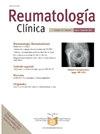Role of the anti-RO/SSA antibody in patients with systemic lupus erythematosus
IF 1.2
Q4 RHEUMATOLOGY
引用次数: 0
Abstract
Background
Patients with systemic lupus erythematosus (SLE) and anti-Ro+ antibody frequently pose a diagnostic and therapeutic challenge for the specialist, as they frequently present sicca syndrome, overlapping with Sjögren's syndrome (SS). To date, the clinical and prognostic variability that this antibody confers on SLE patients is not well characterized.
Objectives
To investigate the possible clinical, analytical, therapeutic and prognostic implications of anti-Ro antibody in SLE. Furthermore, we analyzed the possible implications of the expressed anti-Ro profile (subunit 52, 60 or both) on the disease phenotype.
Methods
The medical records of patients with anti-Ro+ and - SLE, primary SS and SLE/SS overlap have been reviewed.
Results
Anti-Ro+ SLE presents less arthritis, low C4, expression of DNA Crithidia and need for bolus corticosteroids than anti-Ro− SLE, but more xerophthalmia, xerostomia, expression of anti-La, anti-cyclic citrullinated peptide and overlap with other rheumatological entities. Anti-Ro+ SLE and the overlap group behave similarly for multiple variables. SS group shows a higher expression of β2-microglobulin compared to the overlap group. Anti-Ro52+ patients associate more Raynaud's phenomenon than anti-Ro60+ patients. The latter express more lupus anticoagulant and antiphospholipid antibodies than the group with both subunits.
Conclusions
The presence of anti-Ro+ in patients with SLE provides clinical and analytical differences compared to patients with anti-Ro− SLE and SLE/SS. anti-Ro+ SLE and the overlap group behave similarly, but present differential characteristics that postulate them as separate phenotypes of the disease. The different serological profiles of anti-Ro confer specific clinical and analytical characteristics in patients with SLE and SS.
抗ro /SSA抗体在系统性红斑狼疮患者中的作用
背景系统性红斑狼疮(SLE)患者的抗 Ro+ 抗体经常给专科医生的诊断和治疗带来挑战,因为他们经常出现疱疹综合征,并与斯约格伦综合征(SS)重叠。迄今为止,这种抗体给系统性红斑狼疮患者带来的临床和预后变异性还没有得到很好的描述。目的 研究系统性红斑狼疮患者抗 Ro 抗体在临床、分析、治疗和预后方面可能产生的影响。此外,我们还分析了所表达的抗 Ro 特征(亚基 52、60 或两者)对疾病表型的可能影响。方法回顾了抗 Ro+ 和 - 系统性红斑狼疮、原发性 SS 和系统性红斑狼疮/SS 重叠患者的病历。结果 与抗-Ro+系统性红斑狼疮相比,抗-Ro+系统性红斑狼疮患者的关节炎、低C4、DNA Crithidia表达和皮质类固醇注射需求较少,但眼干症、口干症、抗-La、抗环瓜氨酸肽表达较多,且与其他风湿病实体重叠。抗Ro+系统性红斑狼疮组和重叠组在多个变量上表现相似。与重叠组相比,SS 组的β2-微球蛋白表达量更高。抗Ro52+患者比抗Ro60+患者伴有更多的雷诺现象。抗Ro+系统性红斑狼疮患者与抗Ro-系统性红斑狼疮和系统性红斑狼疮/SS患者相比,在临床和分析方面存在差异。抗Ro+系统性红斑狼疮患者和重叠组患者的表现相似,但呈现出不同的特征,因此可将其视为不同的疾病表型。不同的抗-Ro血清学特征赋予系统性红斑狼疮和系统性红斑狼疮患者特定的临床和分析特征。
本文章由计算机程序翻译,如有差异,请以英文原文为准。
求助全文
约1分钟内获得全文
求助全文
来源期刊

Reumatologia Clinica
RHEUMATOLOGY-
CiteScore
2.40
自引率
6.70%
发文量
105
审稿时长
54 days
期刊介绍:
Una gran revista para cubrir eficazmente las necesidades de conocimientos en una patología de etiología, expresividad clínica y tratamiento tan amplios. Además es La Publicación Oficial de la Sociedad Española de Reumatología y del Colegio Mexicano de Reumatología y está incluida en los más prestigiosos índices de referencia en medicina.
 求助内容:
求助内容: 应助结果提醒方式:
应助结果提醒方式:


